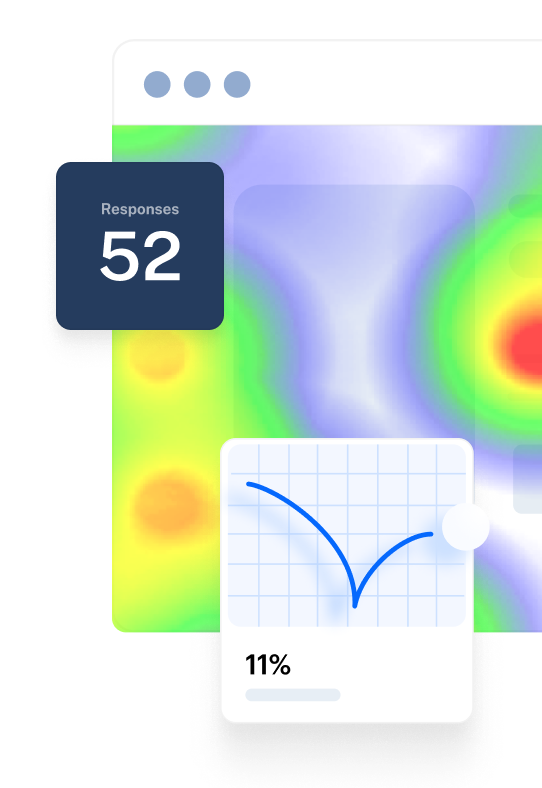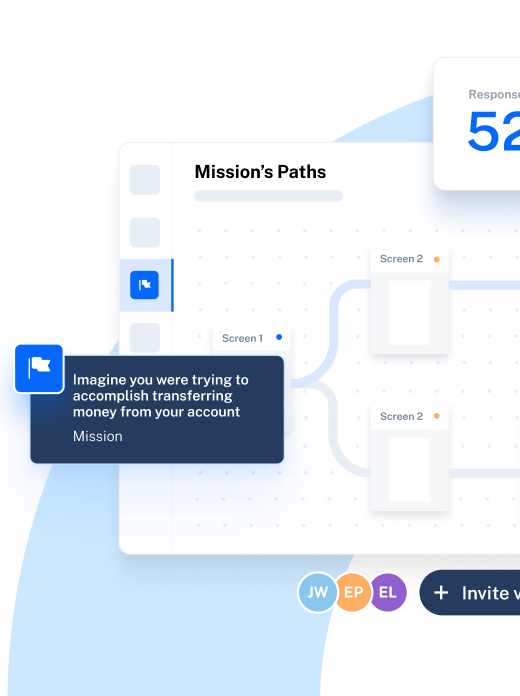Chapter 2
Inclusive design principles: The building blocks to inclusivity
In this chapter, we walk you through the eight key principles of inclusive design to help you implement inclusive design in your organization and create solutions that benefit more users.

Now that we’ve introduced the most common diversity types and fundamental ways to be more inclusive, it's time to look at the concrete steps you can take to put inclusive design into practice. Here are eight inclusive design principles you can follow:
- Discover your own biases
- Uncover user needs and pain points
- Be transparent and descriptive
- Apply a holistic approach
- Anticipate your product’s impact
- Hire for diversity
- Get out of your bubble
- Be intentional
We’ll look at them in more detail in a moment, but first, let’s consider why inclusive design is essential to building a better product and reaching a broader audience who can benefit from your solution.
Why is inclusive design important?
Inclusive design aims to create products and services that serve as many people as possible and ensure no one gets left behind. Hopefully, the reason why inclusive design is necessary is starting to resonate. If we don't design inclusively, we risk excluding many people from using our products and services and, ultimately, from living their lives comfortably.
A prime example of making people’s lives less comfortable due to exclusion is how most bicycle seats are uncomfortable for women as these were designed for a man's anatomy. Georgena Terry saw this as an opportunity and invented the first female bicycle saddle in the early 1990s.
Inclusive design makes us all a little more empathetic and perhaps even brings a sense of gratitude when we think about all the products that have been created thanks to others who adopted this mindset.

Melanie Buset
User Research Manager at Spotify
Share
When we think of inclusive design, we might think of the tech world, but the reality is that design affects every aspect of our lives. When design is good, it's almost invisible, and we're probably not even aware that literally everything around us has been designed.
Like Erika Hall, design consultant and co-founder of Mule Design Studio, states in this podcast episode, "the most important design you can work on is invisible. It's what's happening under the surface that you don't have to pay attention to. And now that attention is our most scarce and exploited resource, designing something that goes without notice could be the greatest service you do."
Because of inclusive design, I can type these thoughts on my keyboard, and you can read or listen to them thanks to the screen or screen reader you're using.
One crucial element of inclusive design that people sometimes overlook is the shift it can have on our mindset when we're no longer only thinking about ourselves. Inclusive design makes us all a little more empathetic and perhaps even brings a sense of gratitude when we think about all the products that have been created thanks to others who adopted this mindset.
What is the cost of not being inclusive?
Ignoring inclusive design best practices may unintentionally lead to products that are discriminatory against specific user segments. As a result, it may also prohibit business growth opportunities. According to the European population projections, by 2050, 40.6% of Europe's population will be 55 or older. Creating products for a target group of 18-35 will therefore exclude a large portion of society and lead to many missed opportunities.
In practice, the cost of bias or not being inclusive could lead to entire generations feeling lost on how to contact officials or be a part of society simply because they don't have the latest technology. It could lead to missing out on hiring fantastic candidates because algorithms filter candidates based on their education level. In some cases, it could even increase the risk of injuries or death.
As this study reports, "male and female bodies perform differently in crashes, but the vast majority of automotive safety policy and research is still designed to address the body of the so-called 50th percentile male." This results in women being more likely to be killed (+17%) or injured (+73%) in a car accident. This could have been avoided if women had been involved in the research and design process. The re-design of car interiors could have also been avoided, saving these companies millions.
Designing for inclusivity
The most successful companies are aware of the risks of not designing inclusively and have put a lot of time and effort into ensuring they’ve built teams with an inclusive foundation.
Most major tech companies have created their own “inclusive design manifestos” to set some standards to follow when it comes to design. Shopify's design guide recognizes the variety of what it means to be inclusive by including, "disabilities may affect how people move, see, hear, communicate, learn, understand, and process information. As a result, it’s important to consider how to design and develop your product to support a wide range of needs and experiences."
Another great example is Apple and its best practices for inclusive design, "an inclusive app puts people first by prioritizing respectful communication and presenting content and functionality in ways that everyone can access and understand.” Best practices that can help you create an inclusive app are using plain inclusive language, avoiding unnecessary references to specific genders, creating copy and images that portray human diversity, and designing with accessibility in mind.
Finally, Microsoft recognizes that “exclusion happens when we solve problems using our biases. As Microsoft designers, we seek out those exclusions, and use them as opportunities to create new ideas and inclusive designs."
As you can see, there is no one-size-fits-all document that every tech company follows. As an organization and with your company values taken into consideration, you can decide what principles are most important to your team and your users. Below are some examples to get you started.
8 Principles of inclusive design
1. Discover your own biases
Truly being inclusive means discovering and becoming aware of your personal cognitive biases and prejudices, and how these could affect the people around you. If you're unaware of them, how could you possibly overcome cognitive biases, and know for sure that you’re being inclusive? Sometimes biases can be so deeply ingrained that we don't even know we carry them. That's why it's important to challenge ourselves and take some time to do a bit of self-discovery. Again, we’re making decisions that impact people’s lives, sometimes greatly so.
Deconstructing biases and assumptions is an essential UX design principle every designer should embrace. Work towards removing your existing biases through diverse thinking, questioning, and understanding of your users. As mentioned in chapter one, here are some ways to start discovering your biases and designing more inclusive and accessible products:
- Take an online test, such as the Implicit Association Test (IAT) developed by Harvard University. This 10-15 minute test will allow you to assess your conscious and unconscious preferences for over 90 topics ranging from pets to political issues, ethnic groups to sports teams, and entertainers to styles of music.
- Attend an unconscious bias training. For example, in this unconscious bias online class offered by LinkedIn Learning, a diversity expert reveals the most common forms of unconscious bias and teaches the skills to address them effectively.
- Make sure that everyone has a voice and that different perspectives are involved in your design process. A great way to do so is to conduct research and test your design solutions with a variety of individuals that are dissimilar from you.
2. Uncover user needs and pain points
To be even more sure that you're not bringing your biases into the design process and final product, take some time to understand your users. Conducting product research at each stage of the process is a great way to build empathy and create truly customer-centric products.
Suppose your goal is to help make people's lives easier by solving problems with technology. In that case, you'll need to conduct generative research to obtain a deep understanding of your users' needs, pain points, and behaviors and the problem you're trying to solve for them.
Once you've generated ideas based on your users’ input, create a prototype to test your solution with a diverse group of users and iterate your design to ensure it meets their expectations. All product decisions should be evidence-based and not built off assumptions.
Tip 💡
Involve users from different backgrounds, genders, races, ages, and abilities in the design and research process to ensure you create an inclusive and accessible product.
3. Be transparent and descriptive
When designing solutions, be honest and offer guidance to your users. Present a clear, straightforward interface, follow onboarding best practices to help users learn how to use your product, and assess and avoid dark patterns in your design. Showing transparency in your work will provide users with more value and create better user experiences. Practically speaking, use descriptive and simple language on CTAs, landing pages, product pages, etc. Content testing is an excellent way to ensure your content is understood and well-perceived by as many users as possible.
4. Apply a holistic approach
Give it all or nothing. Don’t use inclusive design only as a way to hook more users in and then give up on providing them the best experience possible. Inclusivity should be considered throughout the entire product development process holistically. Review the end-to-end experience with real users to uncover any pain points or gaps and ensure the inclusive design and accessibility standards are applied throughout the process—from ideation to delivery.
Gather user feedback and satisfaction with Maze
Quickly create and share dynamic user surveys that transform responses into quantitative results, so you can support iterations and improvements with real data.

5. Anticipate your product’s impact
Part of being inclusive means understanding the intentions, goals, and shortcomings that your product may have. Consider various scenarios, take time to understand your product's impact on the people using it, and ask if there's any way your solution might be harmful.
You can do this by digging deeper into your user needs via research and asking yourself, “are there any reasons you shouldn't move forward with a particular decision?" For example, if you decide to make a passport renewal process 100% digital, you would exclude anyone who doesn't have access to a computer or introduce an additional level of complexity for those who would have to try to find access to one.
6. Hire for diversity
Building an inclusive product also means building an inclusive team. Ensure your team is diverse and is seeking diverse perspectives and opinions about their work. Inclusive design focuses on the full range of human diversity, which should be reflected in your UX team and organization. This also means hiring people with different knowledge, backgrounds, ages, gender, culture, education, and more.
7. Get out of your bubble
Another habit you should be aware of is working in a bubble. This could mean not sharing your work regularly or with a broad enough audience. "If we constantly review work with designers or the same people in our squad, we can unknowingly start to cater our design solution to what they like because we know they'll get approved," says Product Designer Miguel Hernandez. Anyone directly involved in building a product can have their reasons for wanting a specific solution that may not necessarily reflect the needs of the end users.
A good way to combat designing in a bubble is to host design critique meetings with non-designers. Dropbox and Figma created helpful how-to documentation for running a successful design critique. Just remember to invite people from different departments, i.e., researchers, product managers, engineers, marketers, etc.
8. Be intentional
It may not be possible to immediately focus on all user needs, but any decision should be intentional and planned. It is often best to focus on solutions that meet most needs, even though not all of them. You can plan for future iterations and build on these solutions to address more complex problems.
Just like diversity itself isn’t one-size-fits-all, neither is the way your organization decides to introduce more inclusive practices. However, the topic should at the very least be discussed regularly, and you should always consider a diverse range of individuals in your design practice. The reality is that not every single person in the world may want to use your product. Still, if you follow these inclusive design principles, you will at least be giving more people the chance to try your product. Building a diverse team and collecting product feedback from more of your users is a great place to start.
Design, test, and iterate fast with Maze
Get actionable user insights you can act on instantly and create better, more inclusive user experiences.

Frequently Asked Questions
What are the principles of inclusive design?
What are the principles of inclusive design?
The inclusive design principles establish concrete steps to build products more inclusively. There are many different ways to describe these principles, but here we've outlined the eight most important ones:
- Discover your biases
- Uncover your users’ needs and pain points
- Be transparent and descriptive
- Apply a holistic approach
- Anticipate your product’s impact
- Hire for diversity
- Get out of your bubble
- Be intentional
What is an example of inclusive design?
What is an example of inclusive design?
An example of inclusive design is the Apple Emoji library. While in 2008 (iOS 2.2), all the hand emojis were representative of a white-caucasian male, in 2015 (iOS 8.3), they started to represent a more diverse population. Apple has also added more emojis to represent physical capabilities, food, faith, flags, etc.
Why do we need inclusive design?
Why do we need inclusive design?
Inclusive design leads to a more inclusive world. If more people are considered in product design and treated with equal importance, this process may have a ripple effect on other areas of life. Being inclusive means adjusting our thoughts to not only our needs but also what others need.


